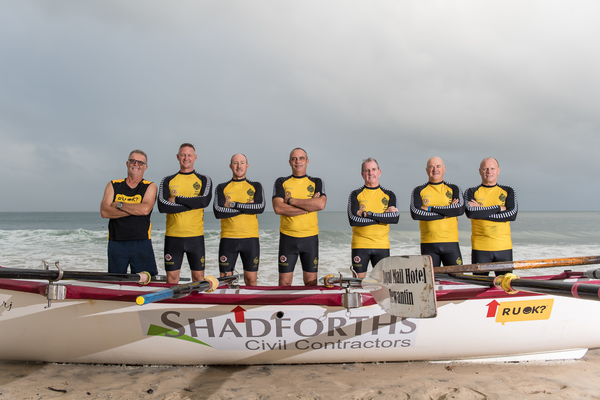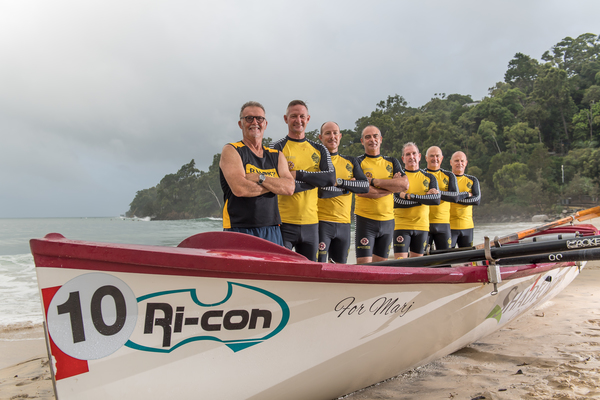By Ron Lane
They call it the George Bass Marathon, and it is rated the toughest surf boat race in the world; seven unforgettable days of rowing. Seven days of rowing on the ocean in an open surf boat.
Now for the first time in the clubs proud history of boat racing, the Noosa Heads Surf Life Saving Club entered the George Bass Marathon. Despite not finishing in the top three, they finished with what boat sweep Shane Rattovich described as a truly outstanding performance.
The sweep and eight rowers who proudly wore the club colors of maroon and white were; Shane Rattovich(sweep) aged 45,John Jenkins 54,Mick Curwen 59,Steve Hatton 55,Chris Beaufort 58, Steve Matters 62, Warren Whitten 55,Gerard Broersen 48 and Steve Porter the baby of the crew 44.
“For a crew of first timers it was a great effort they did their club proud; and when you considering they are a crew of veterans with an average age of 55 years, it makes their performance one to remember.”
Shane, who is a former old boy of Noosa now living in New Zealand, returned to his old club to take part and in doing so took his place in the crew as sweep. The crew for each days racing would consist of the sweep and four rowers.
“This year 2018 with the Noosa Surf club celebrating its 90th year of service to the community, it was indeed fitting that this team of boatmen accepted this almighty challenge to participate in what can only be described as the toughest event of all,” said Noosa Governor John Little.
The total team involvement consisted of a sweep, eight rowers, support team of two plus helpers.
In the information brochure it was described as, “an event where personal challengers are met and lifelong friendships are formed as part of the George Bass Marathon family.”
The preparation for the crew known as the Condors, took months of training; not only rowing but also road work and weights. This was necessary for not only body fitness but also to develop a mental attitude that would prepare them to cope with anything that mother nature could throw at them; heat, rain, sunburn, mountainous seas, blue bottles and fatigue.
“With the possibility of being confronted with such, a positive and tough mental attitude is of the utmost importance,” said the sweep.
Where did it all start? The concept for this event came into being when the early explorer Surgeon Commander George Bass in 1797, took a boat crew of six rowers to explore and chart sections of the East Coast of Australia. Little did he realise that 178 yrs. later(in 1975) twelve surf boats rowed by Australian lifesaving, plus a crew from Atlantic College in Wales, would use his charted course as the bases for a surf boat race; a race to both honor his name and commemorate his achievement.,
It was in 1974 that it became the brain child of Bega newspaper editor Curly Annabel. “However on discussing the concept with friends they thought he was mad; as a result no support was forth coming. It wasn’t until some months later that NSW Secretary and Cronulla boat sweep legend Nick Dixon took up the cause and the challenge. The rest is now history.”
‘’Held every second year with a New Years Eve start, the race commences at Batemans Bat and finishers at Eden,” said Rattovich. “For each of the seven days the distance covered is different; first leg being 27kl,and the following six being 19, 22, 24,35 (the longest leg), 27 and the final leg into Eden 22kl.
Each day we start the race in deep water between markers at the back of the surf break. The finish line would also be between markers beyond the break at the allocated beach.”
After leaving Batemans Bay they have nightly stop overs and their starting beaches for the next six days were; Moruya, Coila Beach,Narooma, Bermagui,Tathra and Merimbula.The finish line would be Aslings Beach Eden.
For the race each crew is covered by a support boat and the role of this craft is of the utmost importance. Each boat is manned by crew of two Noosa club mates plus the relief rowers of the day; on board they also carry extra food and water. The support rowers may be changed around as many times as required.
“Despite being listed as a marathon the changeover of crewman enables us to row at almost race pace. This however only serves to add to the toughness of the event,” said Steve Hatton, “a marathon at race pace.”
When a changeover is called by the sweep, the duty boat is positioned some 100 meters to the front and the relief rowers’ drop into the water. As the surf boat reaches them, those to be relieved leave the boat, slide into the water and assist their relief to pull themselves aboard. “On days 1, 5, and 7 a total of eight rowers can be used and on the other days six,” explained rower Steve Hatton.
Normally once practiced it was simple. However on day 2, a huge problem surfaced. Blue Bottles.
“Big clusters of them,” said Mick Curwen, “and they were big and their tentacles were long; not like the little ones we see at home.” While Noosa relief rower Gerard Broersen was floating waiting for their boat he was stung and as he changed with John Jenkins, Jenkins was also hit by the long tentacles. “Not a happy scenario,” said Mick, ‘’but when you do the Marathon these things happen.”
‘’Day 3 the ignition switch on our support boat snapped,” said skipper Steve Freckelton, “so a changeover was not possible. The same crew rowed the full 22kl,”
Then on day 5 Mother Nature presented another problem when a rather large shark surfaced next to the boat and stayed with them for some distance. ‘’It came as a real shock,” said Steve Porter. “One minute all was well the next there it was, right next to the boat. However this time we were lucky because there were no rowers in the water waiting for a change over.”
The support crew for Noosa was Steve Freckelton and Joel Tweedy and in the words of rower Steve Hatton, “Their role as our support team was vital and it was spot on; we couldn’t have asked for better.”
Then after seven days it is all over. ‘’The blisters are counted, the sharks are gone Blue Bottle scars remain and the fatigue slowly begins to fade; it’s time for the journey home,” said stroke Chris Beaufort.
When asked would they return in two years, they all looked at one another and in typically Aussie fashion, our Noosa Condors answering with a laugh, “My bloody oath mate, we’re going back; this is just the start”
Speaking on behalf of all team members Mick Curwen added. “To all of those who supported our fund raising raffles and groups who stepped forward as sponsors, you made our success possible. We can’t thank you enough.”
Like all major sporting events the Marathon has had its ups and downs. However “in 1986 the Commonwealth Bank came to the party with a contribution of $20,000; then two years later the entries for the race reached 26. Then in 1990 a race budget of $400,000 was achieved and a record 38 crews heard the starters’ gun: then in the late 90s 11 female crews also took part and surf ski competitors made their appearance.”
We now live in an era where pride tradition and loyalty is being slowly eradicated. So to our Noosa Condors; Jenko, Haddo, Mickey, Scruffy, Chris, Gerrard, Jingles, Wazza and Ratto, your loyalty goes back many seasons, your pride is beyond question and your belief in tradition (69 years of boats in Noosa) goes without saying. So we say not only on behalf of the Noosa club, but also our community, “Well done gentlemen you did us proud.”







